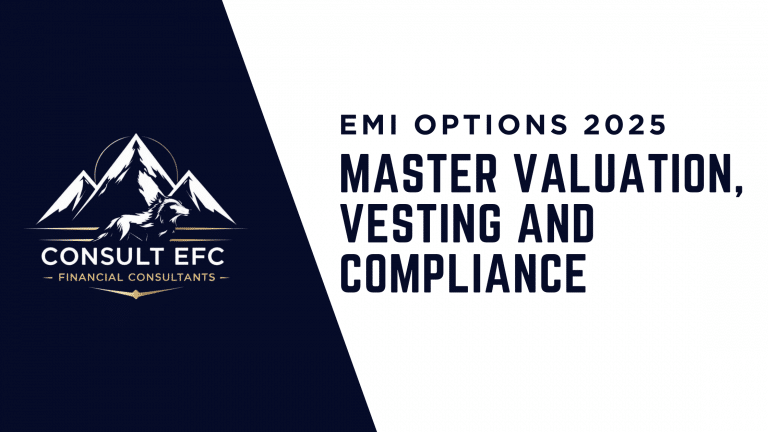Thinking about giving staff a real stake in growth? EMI options let UK companies reward employees with shares, with tax breaks that protect value on exit and keep costs down.
In 2025, HMRC has kept the focus on timely reporting and clean records. Grants made in the 2024 to 2025 tax year must be notified by 6 July 2025, and the annual return is due the same day. Miss those and you risk losing tax reliefs that make EMI worthwhile.
Getting valuation right comes first. A robust, well‑evidenced share valuation supports your exercise price, reduces risk at exit, and helps defend your position if HMRC asks questions. Consult EFC prepares clear, defensible valuation reports that align with current guidance and real market data.
Vesting should match how your team delivers value. Time‑based, performance‑based, or hybrid schedules all work, as long as terms are written and consistent with EMI rules. Keep records tight and communicate the plan in plain language.
Know the disqualifying events that can switch the tax treatment. A change to working hours, a company takeover, or altering terms outside the rules can trigger a 90‑day clock to exercise. If that window is missed, more of the gain can be taxed as income.
Filings are the backbone of compliance. You need to register the scheme, notify each grant on time, and submit the annual return. Keep grant docs, board minutes, valuations, and employee agreements aligned.
This guide sets out what founders, CFOs, and HR leads need to know now. Expect clear steps on valuation, vesting design, risk points, and the filings that keep your EMI benefits intact.
EMI Options Basics: Valuation and Vesting in 2025
Set the value, set the tone. In 2025, HMRC is strict on evidence, timing, and record keeping. A clean valuation underpins EMI tax reliefs, keeps your exercise price defensible, and reduces stress at exit. Vesting then controls how and when people earn ownership. Get both right and you build a plan that retains talent and stands up to scrutiny.
How to Value Your EMI Shares Correctly
A solid EMI valuation follows clear steps. Keep it simple and do it by the book.
- Gather the facts
- Up-to-date cap table and share rights.
- Current and forecast financials.
- Recent fundraising terms, offers, or M&A interest.
- Any major events after the last valuation.
- Get professional advice
- Use an advisor with EMI experience and market benchmarks.
- Ask for both values HMRC expects: the unrestricted market value (UMV) and the actual market value (AMV, reflecting restrictions on the shares).
- At Consult EFC, we prepare concise, defensible reports that make HMRC agreement smoother and faster.
- Submit the valuation to HMRC Shares and Assets Valuation
- Use the ERS online valuation service to seek an advance agreement for EMI.
- Include your report, cap table, articles, option rules, and any recent term sheets.
- Keep emails and reference numbers in your audit trail.
- Wait for HMRC agreement, then grant within 90 days
- HMRC’s agreement usually stands for 90 days. If a material event occurs, refresh the valuation.
- Grant options within that window, then document the exercise price and option terms.
- Notify HMRC on time
- For options granted on or after 6 April 2024, notify each grant by 6 July following the end of that tax year using EMI1 via the ERS service.
- File your annual return by 6 July as well. Late filings can cost EMI tax reliefs.
Key risks to avoid:
- Overvaluation
- Sets an exercise price that is too high, reducing employee upside.
- Undercuts the incentive and can harm recruitment or retention.
- Undervaluation
- If the exercise price is below AMV, employees face income tax and possibly NIC on the discount at exercise.
- HMRC can challenge and dispute gains at exit if the evidence is weak.
- Poor evidence
- Missing documents or vague methods invite questions.
- Any discrepancy with fundraising terms can trigger a rework.
Helpful tools and advisors in 2025:
- Cap table platforms with data rooms to keep documents aligned.
- Consult EFC for tailored EMI valuations, HMRC-ready reports, and guidance on timing, grant mechanics, and record keeping.
Example that works:
- A seed-stage company with a recent SAFE sets UMV with proper discounts for minority and lack of marketability, gets HMRC agreement, then grants within 90 days. Employees avoid income tax on exercise because the strike price matches AMV at grant, and the company avoids disputes on exit.
Vesting Schedules: Locking in Employee Loyalty
Vesting links ownership to time served and results delivered. Keep it fair, simple, and aligned with milestones that matter.
Common plans that work:
- 4-year vesting with a 1-year cliff, then monthly vesting
- Example: 25 percent after 12 months, then monthly over 36 months.
- Hybrid vesting
- Time-based vesting plus a performance trigger, such as product launch or revenue target.
- Exit-only vesting
- Options vest and become exercisable only on an exit event, common in early stage companies that prefer fewer exercises before a sale.
Exercise windows after vesting:
- Standard EMI options allow up to 10 years from grant to exercise, subject to your plan rules.
- Leaver rules matter. Good leavers often get 90 days to 6 months to exercise vested options. Bad leavers usually forfeit unexercised options.
- Exit events often include a short window to exercise vested options if they are not exit-only.
What ties vesting to growth and retention:
- Clear milestones that mirror company value drivers. Shipping a core feature, hitting ARR thresholds, or passing regulatory gates are all direct signals of progress.
- Consistent communication. Staff know what they must achieve and when their options become exercisable.
- Balanced pacing. Too slow and you weaken the incentive. Too fast and you reward before value is proven.
Practical tips:
- Keep vesting terms tight in the option agreement. State cliffs, cadence, performance tests, leaver terms, and any board discretion.
- Avoid changes that let employees exercise earlier than intended, since this can affect EMI tax status.
- Review vesting annually against strategy. If your go-to-market shifts, update future grants rather than revisiting old ones.
Bottom line: a clean valuation and a sensible vesting plan work together. You give staff real upside tied to outcomes, and you keep EMI tax benefits intact with strong evidence and on-time filings. Consult EFC can help you set the value, document it well, and structure vesting that your team understands and trusts.
Disqualifying Events: Protect Your EMI Benefits
EMI reliefs depend on continuing to meet the rules after grant. When a disqualifying event happens, a 90‑day clock usually starts. Move fast, document everything, and keep the option holder informed. At Consult EFC, we help clients spot risk early and keep evidence tight, including valuation support to apportion gains and preserve relief where possible.
Common Disqualifying Events and How to Spot Them
Certain changes switch the tax treatment of EMI options. The list below covers the most frequent triggers and the early signs to watch.
- Ceasing to meet the working time requirement
- The employee drops below 25 hours per week, or less than 75 percent of their working time for the company.
- Signs to act: part‑time requests, extended leave that is not protected, second jobs, or a role change reducing contracted hours.
- Ending employment
- Resignation, dismissal, or expiry of a fixed‑term contract.
- Signs to act: notice given or received, performance processes, redundancy consultation. Treat the last day of employment as the event date.
- Company loses independence or control changes
- The company comes under the control of another company, such as on acquisition. Options may be exchanged into options over the buyer’s shares if structured correctly.
- Signs to act: signed heads of terms, board approvals, share exchange drafts, or new majority investors with control rights.
- Option is transferred or used as security
- EMI options are personal and non‑transferable, other than on death.
- Signs to act: requests to assign options, trust or nominee arrangements, or any pledge of options.
- Option terms are varied to increase value
- Adjusting exercise price, vesting, or share class to boost value can trigger an event.
- Signs to act: amendments to the option agreement, new articles, or board resolutions altering rights of the underlying shares.
- Company ceases to carry on a qualifying trade
- Moving into excluded activities or stopping trade.
- Signs to act: strategic pivot to non‑qualifying activities, sale of core trade, or winding‑down plans.
- Grant breaches statutory limits
- Options that take an individual over the £250,000 unexercised EMI limit at grant, or grants outside the 3‑year qualifying window for replacement options, are not qualifying.
- Signs to act: multiple awards close together, unclear tracking of individuals’ EMI headroom.
Practical checks to run monthly:
- HR leaver report matched to the option register.
- Working time confirmations for EMI holders in flexible roles.
- Company transaction watchlist with legal flagged for potential control changes.
- Cap table and share rights changes reviewed before board approval.
Consult EFC can review your plan rules and board papers, and provide a quick risk memo so you act within the window.
What Happens After a Disqualifying Event
Once an event occurs, time matters. The key steps protect relief and reduce tax exposure.
- The 90‑day exercise period
- If the option holder exercises within 90 days of the event, EMI tax treatment can still apply on the gain built up to the event date. Any growth after the event may be subject to income tax.
- After 90 days, more of the gain can be taxed as income, and employee and employer NIC may arise.
- Tax if the 90‑day window is missed
- Expect income tax on the increase in value since grant or since the event, depending on the facts and any prior chargeable elements. CGT treatment may still apply to any residual part of the gain linked to the period before the event, but the benefit is reduced.
- A clean valuation at grant and a point‑in‑time value at the event date support the split. We prepare concise valuation reports that help apportion gains and defend your position.
- Good leaver and bad leaver outcomes
- Good leaver (for example redundancy, ill‑health, or other plan‑defined reasons): vested options usually remain exercisable for a set period under plan rules. The EMI 90‑day tax window still applies from the event date. On death, the estate typically has up to one year to exercise and still access EMI relief.
- Bad leaver: unexercised options often lapse under plan rules. If any remain exercisable, the same 90‑day tax clock applies for EMI treatment.
- Documentation to retain reliefs
- Event date evidence: resignation letter, board minutes, share purchase agreement, or working time notice.
- Option paperwork: grant letters, plan rules, vesting records, and any variation documents.
- Valuations: grant valuation (UMV and AMV) and an event‑date value to support tax apportionment.
- HMRC filings: report the disqualifying event and any exercises on the ERS annual return by 6 July following the tax year. Keep correspondence and reference numbers.
- Payroll records: if income tax or NIC arise, process through PAYE where required and keep payslips, RTI submissions, and tax calculations.
Fast action guide:
- Confirm the event date in writing.
- Notify the option holder of the 90‑day deadline and expected tax.
- Run an event‑date valuation to quantify exposure.
- Prepare exercise paperwork or, if relevant, an option exchange on acquisition.
- Update registers, payroll, and the ERS return.
Need support within the 90‑day window? Consult EFC can produce event‑date valuation evidence, check your leaver terms, and prepare a clean audit trail so you retain as much EMI relief as possible.
HMRC Filings: Stay Compliant in 2025
EMI tax benefits depend on clean filings and tight records. In 2025, timing is simple. Notify grants made in the 2024 to 2025 tax year by 6 July 2025, and file the EMI annual return by the same date. Miss either and you risk penalties and, for late grant notifications, loss of EMI relief. At Consult EFC, we prepare valuation reports that slot neatly into your ERS filings and support your audit trail at exit.
Step-by-Step Guide to EMI Notifications
New EMI grants must be notified online through HMRC’s ERS service. The process is quick if your documents are in order. In 2025, grants made between 6 April 2024 and 5 April 2025 must be notified by 6 July 2025. For grants in 2025 to 2026, the deadline is 6 July 2026.
Follow these steps:
- Register your EMI scheme on ERS
- Use your Government Gateway account to add ERS and register the EMI scheme before you upload any notifications.
- Gather the details for each grant
- Employee information and National Insurance number.
- Grant date, number of options, exercise price, exercise window, and vesting terms.
- Share class and rights that match your articles and plan rules.
- Valuation evidence, including UMV and AMV at grant, with the HMRC agreement reference if obtained.
- Complete the ERS grant notification
- Use the ERS EMI grant template, often referred to as EMI1 in HMRC guidance.
- Upload the file through ERS for each grant made in the tax year.
- Check for validation errors and correct them before final submission.
- Keep a full audit trail
- Board minutes approving the grants and the share valuation.
- Option agreements signed by both parties.
- The valuation report and any HMRC agreement emails.
- ERS submission receipts and reference numbers.
- Retain records for at least 6 years.
- Align to 2025 deadlines
- Grants in 2024 to 2025 tax year: notify by 6 July 2025.
- Future years: the deadline is 6 July following each tax year.
- If a material event occurs after valuation and before grant, refresh the value and document the change.
Example that works: grant options within 90 days of HMRC agreeing your EMI valuation, then submit the ERS grant notification well before 6 July. This keeps the strike price defensible and the report error-free. Consult EFC provides concise EMI valuation reports that align with HMRC expectations and make notifications straightforward.
Annual Returns and Avoiding Penalties
Every company with an EMI scheme must file the EMI40 annual return on ERS by 6 July following the tax year, even if there is nothing to report. A nil return is still required.
What the EMI40 should cover:
- All active EMI options at the end of the tax year.
- Grants made during the year that were notified through ERS.
- Exercises during the year, with dates and numbers of shares.
- Lapses, cancellations, and any disqualifying events.
- Any variations to option terms that affect value.
How to avoid penalties:
- File by 6 July. A one-day delay can trigger an initial £100 penalty, with further penalties if the return remains outstanding.
- Keep your cap table, option register, and HR leaver data in sync.
- Validate figures against payroll where income tax or NIC arose on exercise.
- Reconcile totals to your board minutes and share allotment records.
If you spot an error:
- Correct the return as soon as possible by submitting an amended EMI40 on ERS.
- Fix the source record, not just the return. Update the option register, payroll records, and board papers if needed.
- Keep a note explaining the correction, the date made, and who reviewed it.
- Late corrections may not remove penalties, but they reduce ongoing risk and future HMRC queries.
Practical preparation checklist:
- Confirm all grants have an ERS notification reference.
- Tie out exercises to share allotment filings and payroll.
- Match lapses to HR leaver reports.
- Retain valuation reports, including event-date values where relevant.
- Export ERS submission receipts for your audit file.
Consult EFC supports clients with HMRC-ready valuation reports and tidy documentation that underpins EMI40 entries. Clean inputs lead to clean returns, fewer queries, and preserved EMI relief on exit.
Conclusion
Strong EMI plans in 2025 start with a clear, defensible valuation and a vesting schedule that reflects how your team creates value. Keep a close eye on disqualifying events, record them fast, and act within the 90‑day window. File every grant and your annual return by 6 July, and keep your audit trail tidy. These steps protect tax relief and reduce risk at exit.
Use the plan to reinforce your culture. Simple terms, fair pacing, and clean documents help staff see the upside and trust the process. Where facts change, update future grants rather than rewriting history.
Consult EFC prepares concise EMI valuation reports, aligned to current HMRC practice, with the right evidence for advance agreement and future exit reviews. We also support event‑date valuations and documentation that keep reliefs intact.
Take the next step today. Confirm your company’s eligibility, sense check recent grants, and set your filing timetable. If you want a quick review or a tailored valuation, speak to Consult EFC. EMI remains a smart, tax‑efficient way for UK businesses to reward growth and keep great people.






